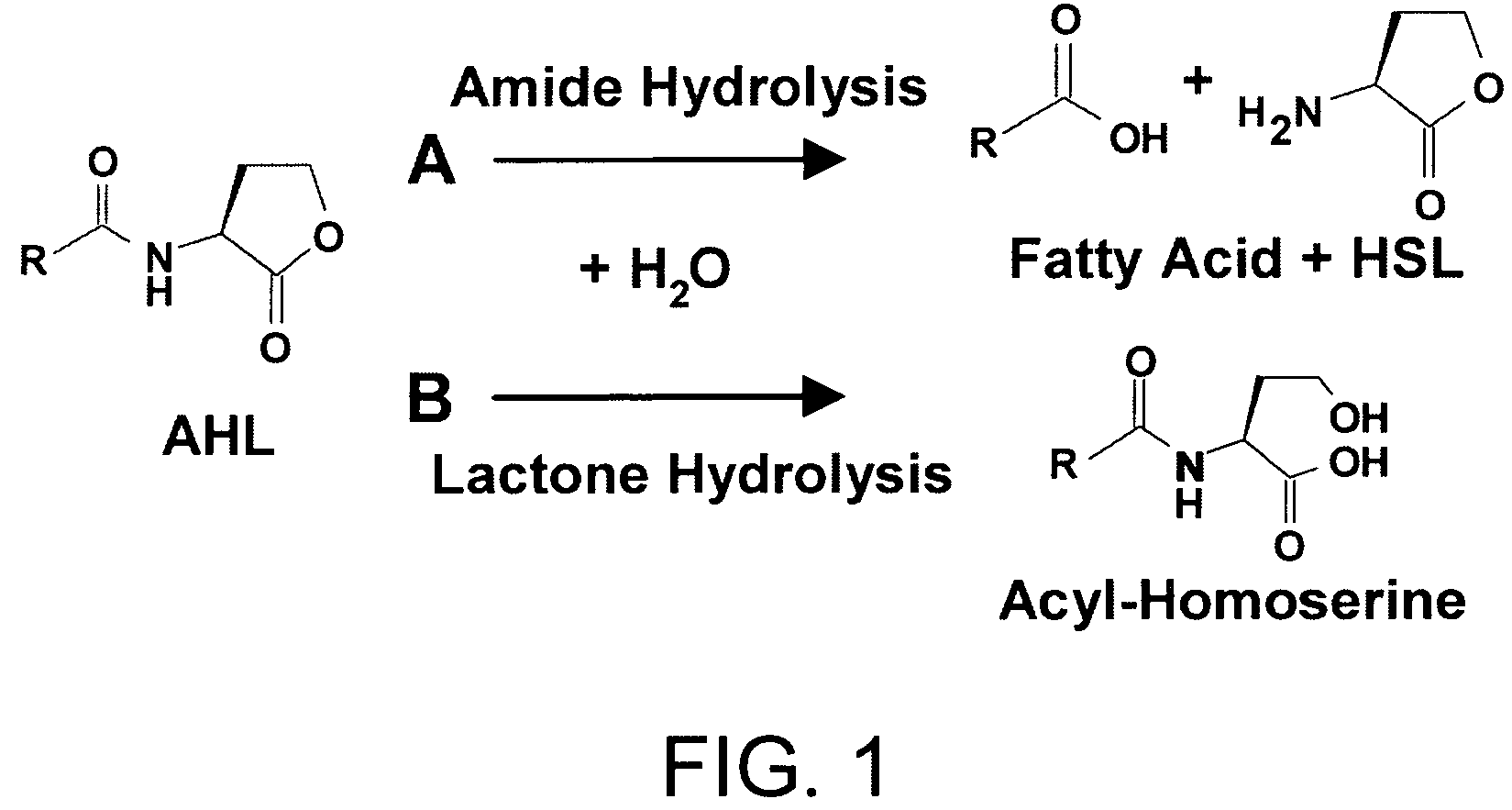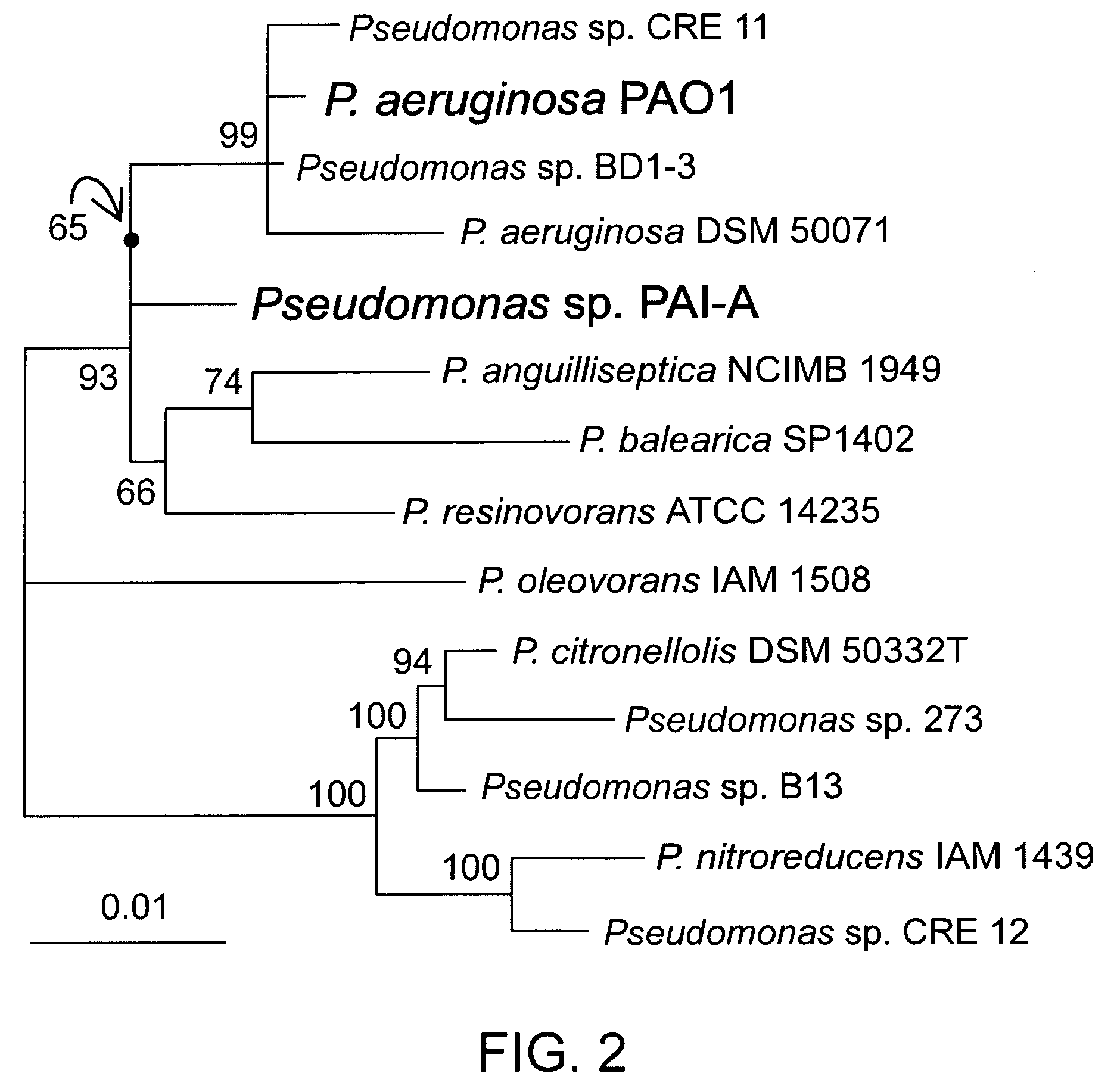Method of Identifying Agents that Inhibit Quorum Sensing Activity of Gamma-Proteobacteria
a technology of gamma-proteobacteria and quorum sensing activity, which is applied in the field of screening assays, can solve the problems of high mortality rate, high mortality rate, and high screening cost, and achieve the effect of high screening throughpu
- Summary
- Abstract
- Description
- Claims
- Application Information
AI Technical Summary
Benefits of technology
Problems solved by technology
Method used
Image
Examples
example 1
Isolation and Growth of Pseudomonas Strains
[0068]This example illustrates how different Pseudomonas bacterial strains responded when isolated and given only 3OC12HSL-containing medium as an energy source. The bacterial strains used were: Pseudomonas strain PAI-A (isolation described below); P. aeruginosa PA 14 (obtained from Dianne Newman of Caltech); P. aeruginosa PAO1 and QSC 112a (obtained from E. Peter Greenberg of the University of Iowa; 43); P. aeruginosa PAO1 and an in-frame PvdQ-deletion / GenR-cassette-replacement mutant of this PAO1 Denver strain (both obtained from Michael Vasil of the University of Colorado Health Sciences Center; 29); P. aeruginosa PAO1 containing pPvdQ-Nde (see below), a constitutive PvdQ expression vector derived from pUCP-Nde (4); E. coli DH5α carrying pUCP18-Nde (obtained from Ciaran Cronin of the University of California, San Francisco); E. coli BL21PRO containing pPvdQ-PROTet, a pPROTet.E133-derived tet-inducible PvdQ expression vector encoding tetr...
example 2
Characterization of Pseudomonas AHL Acylase Activity
[0085]Cloning and expression of pvdQ (PA2385) encoding a putative P. aeruginosa AHL acylase. Genomic DNA was isolated from P. aeruginosa PAO1 using the DNeasy™ tissue kit (QIAGEN) and used as a template for PCR. The deduced coding region for PvdQ (Gene PA2385; www.pseudomonas.com) was amplified from the genomic DNA using the following primers: 5′-AGGCCAAGCTTATGGGGGATGCGTACCGTACTG-3′ (SEQ ID NO:6) and 5′-GTTATATAGCGGCCGCTAGGCATTGCTTATCATTCG-3′ (SEQ ID NO:7; bold print indicates HindIII and NotI restriction sites, respectively), cloned into the appropriately digested expression vector, pPROTet.E133 (Clontech), and transformed into E. coli BL21 PRO. Recombinant AHL acylase activity was examined as follows. After growth in LB medium containing spectinomycin (50 μg·ml−1) and chloramphenicol (34 μg·ml−1), and after gene induction by the addition of anhydrotetracycline (aTc, 100 ng·ml−1) at 18° C., cells were pelleted and resuspended to a...
PUM
| Property | Measurement | Unit |
|---|---|---|
| pH | aaaaa | aaaaa |
| dissociation constant | aaaaa | aaaaa |
| dissociation constant | aaaaa | aaaaa |
Abstract
Description
Claims
Application Information
 Login to View More
Login to View More - R&D
- Intellectual Property
- Life Sciences
- Materials
- Tech Scout
- Unparalleled Data Quality
- Higher Quality Content
- 60% Fewer Hallucinations
Browse by: Latest US Patents, China's latest patents, Technical Efficacy Thesaurus, Application Domain, Technology Topic, Popular Technical Reports.
© 2025 PatSnap. All rights reserved.Legal|Privacy policy|Modern Slavery Act Transparency Statement|Sitemap|About US| Contact US: help@patsnap.com



